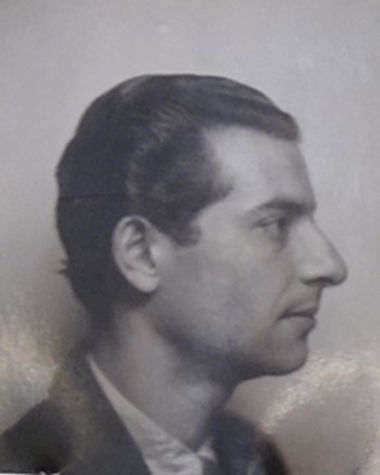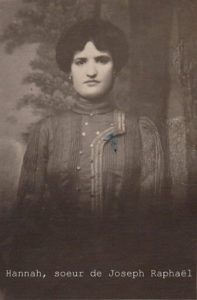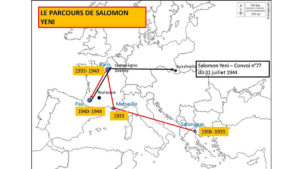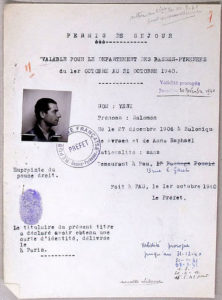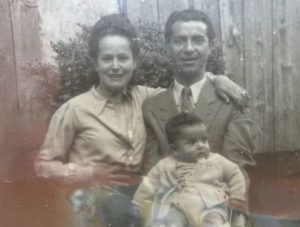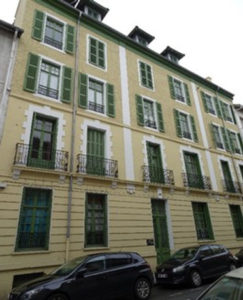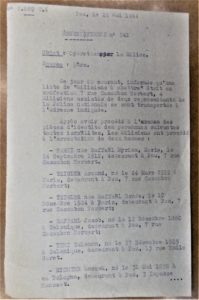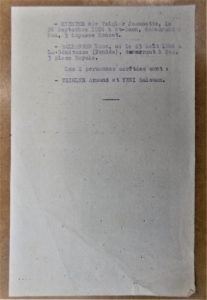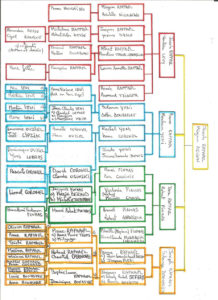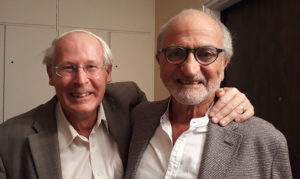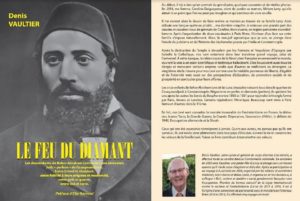Salomon YENI (1905-1944)
A website (in French) has been created about Salomon Yeni’s biography, set in its historical context.
———————————————————————————————–
Για τους Έλληνες αναγνώστες μας, μετά από το κείμενο στα γαλλικά παρατίθεται η μετάφραση στα ελληνικά.
—————————————————————————————
I – Salomon Yeni in Salonika (Thessaloniki)
Salomon Yeni was born on December 27, 1905 (or 1906, depending on the source) in Salonika, now known as Thessaloniki, in the final years of the Ottoman Empire.
He was Jewish (as were 51% of the population of Salonika at that time, representing about 86,000 people) and his family was quite poor (as were 75% of the Jews in Salonika): his father, Abraham, was an egg merchant. His mother, Hanna Rafael, was originally from Smyrna.
Hannah, Salomon’s mother
The Jews of Salonika, who had to pay the dhimmi (taxes levied on non-Muslims throughout the Ottoman Empire), had a degree of religious, cultural, linguistic and administrative autonomy.
They spoke Judeo-Spanish and French.
Since the Thessaloniki records were burned in 1943, we know very little about Solomon Yeni’s younger years, but the historical context helps us to understand what life would have been like for a young Jewish man from Thessaloniki born at the turn of the century, and what might have prompted him to emigrate to France at the age of 25.
Here is a summary of the main events
- 1908: A group of young Turkish officers from Salonika and Macedonia rose up against Sultan Abdul-Hamid II, who they blamed for handing over the Ottoman Empire to foreign powers and also for being overly lenient with the Arabs. The sultan gave in to their demands and redrafted a constitution on July 24, 1908, which was based on secular principles and gave hope for a better outcome for the minority groups in the Ottoman Empire. In reality, however, the opposite happened, in parallel with the rise of nationalism throughout the Balkans and the failures of both the Balkan wars and the Great War.
- 1912: During the first Balkan war (1912-1913), the Ottoman Empire was forced to give up Macedonia, and Salonika became Greek. The Jews saw their way of life transformed as a result of pressure from the Orthodox Greeks (stores had to close on two days a week, Saturday and Sunday; the wages of non-Orthodox people were decreased). All over the region, the Jews were subjected to an upsurge in anti-Semitism.
- 1917: The Great Fire of Thessaloniki. The Jews were forbidden to rebuild in their traditional downtown neighborhoods. They thus rebuilt a vibrant community on the outskirts of the city.
- From 1923 onwards: Nearly a million Orthodox Greeks arrived in Thessaloniki, having been driven out of Turkey after the collapse of the Ottoman Empire. 100 000 of them settled in the city, which almost doubled the urban population. The Jews, who had until then been in the majority demographically, thus became a minority.
- 1931: A pogrom took place in the Campbell district of Thessaloniki, and an anti-Semitic mob set it on fire during the night.
- 1932: The suspected perpetrators of the pogrom were tried and acquitted. At the same time, political instability was making the country increasingly unstable, and this culminated in the formation of a dictatorship in 1936.
- 1933: Salomon left Thessaloniki for France. He arrived in Marseille, on the south coast, on November 1st.
Cartography by D. Vaultier
II – Salomon Yeni in France:
- 1933: Salomon Yeni arrived in France on November 1, via the port in Marseille, on the south coast. He declared that he had been a tailor in Greece. He lived in Paris until 1940.
- 1937: In July 1937, Salomon was living in Paris with his sister, Rachel, who was married. His brother, Jacob, lived and got married in Brussels, Belgium.
Isaac Coronel, Jacob Yeni and his wife Jeanne and Salomon Yeni in July 1937 on the Champs Élysées in Paris
- 1939: Salomon was a commodities broker in Paris. He was living with his partner, Cyrla Buchla Hefter, at 6 rue Mercœur, in the 11th district. Cyrla gave birth to a baby girl, Annette Cécile, on January 6, 1939, but she died later that same day, as did many women up the 1950s. Her father legally acknowledged that Annette Cécile was his child on January 9. She was then placed with a Jewish family in the Beauvais area, made a ward of the State in 1953, and was adopted by Marcel Klopstein and Madeleine Dreyfus in 1959 (source: Senlis Court). On May 27, 1965, she married Michel Louis Alexandre Rognin (born on May 29, 1928 in Marseille and died on October 21, 1974 in Beauvais). She lived most of her life in Crépy-en-Valois, the town where her adoptive parents lived, and in Beauvais, both of which are in the Oise department of France. She died at Beauvais on May 1, 2019.
When he arrived in Marseille, Salomon, like all foreign nationals, was required to make a declaration, which amounted to an application for an identity card. The foreigner’s identity card was first introduced in France during the First World War, according to a decree dated April 2, 1917. This was the first time that a country in Europe had sought to identify all foreign nationals living on its soil. The card reflected a desire to monitor the foreign workforce, to establish a specific legal status for migrants as both foreign nationals and workers, and to impose a special tax on them: in fact, the card was only issued on payment of the tax.
The card was issued by the Central Service for Foreigners’ Identity Cards, which was set up within the General Security Department at the Ministry of the Interior.
From the late 1920s onwards, police surveillance operations increased and the Ministry of the Interior recommended that the Prefectures implement special monitoring systems, which were continued and intensified under the Vichy regime.
- December 1939: Within weeks of the start of the war, Salomon Yeni volunteered to serve in the French army, as a foreigner. He did this on December 12:
- May 10, 1940: Salomon married Esther Benbassat, who was born on May 3, 1919, in Tunisia. Esther was 21 and Salomon 33.
 Salomon and Esther’s wedding photo, taken on May 10, 1940.
Salomon and Esther’s wedding photo, taken on May 10, 1940.
- May 13, 1940: As a foreign volunteer, Salomon was mobilized in the 213th Dépôt de guerre d’infanterie de Versailles (Versailles Infantry war depot). He served in the army from then on but did not take part in the fighting. He was demobilized on July 12, 1940 in Garlin in the Landes department of France, where his wife was already living at the time.
- July 1940: Salomon moved back in with his wife, Esther. They lived in Pau, which was then in the “Free” zone in the southern half of the country.
- September 1, 1940: Salomon declared that he had lost his foreign industrial worker’s identity card during the move to the south of France, and gave this as the reason that he made frequent applications to the Basses-Pyrénées prefecture. He was issued a receipt for each identity card application, attesting to his request for regularization, which he renewed regularly by providing a number of proof of employment certificates. As a result, we know that Salomon had several different jobs during the war: belt maker, tailor and laborer at the Béarn lemonade factory in Pau, for example.
The Yeni family had some relatives come to visit them in Pau: the Raffael family. The Raffael family had been forced to leave Paris: this photo marks the engagement of Salomon’s cousin Armand Tzigler and Renée Raffaël on May 30, 1943 in Pau. They got married on February 24, 1944, 3 months before the entire family was arrested.
- 1940-1944: Throughout their stay in Pau, Salomon and Esther were regularly confronted with the Vichy regime’s bureaucratic requirements. To avoid being obliged to leave Pau, they had to apply to the prefecture of the Basses-Pyrénées department for a residence permit, which was granted to them on October 1, 1940, but only for a period of one month. Salomon and his wife therefore wrote to the prefecture every month during 1941 in order to have their residence permit extended. Then, as of September 2, 1942, the applications were made every three months until September 1, 1944.
- November 1942: The Germans occupied the “Free” zone in the southern part of France.
- February 16, 1943: The STO (Service du travail obligatoire, or Compulsory work service) was introduced.
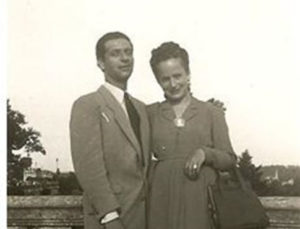 Salomon and Esther, who was expecting twins, in spring 1943
Salomon and Esther, who was expecting twins, in spring 1943
- July 1,1943: Salomon joined the Resistance on July 1, 1943. He was a member of the FFI (Forces françaises de l’intérieur or Free French Forces). On May 1, 1944, he became a sergeant and went by the name of Sylvain (confirmed by Colonel Dauphin, alias Duc, on August 26, 1947).
- October 10, 1943: The Yeni twins, Anne-Viviane and Albert-Jean-Claude (nicknamed Tiste) were born at 23 rue Lespy, in Pau. The little girl died on December 26, 1943.
The Yeni family with little Jean-Claude in the spring of 1944, shortly before Salomon was arrested.
The building at 5 rue Cazaubon-Norbert where the Militia and the police arrested Salomon and his cousins, members of the Raffael family.
- May 20, 1944: Jean-Claude was 7 months old when the militia and the French police arrested his father at his cousins’ house at 7 rue Cazaubon Norbert, after he was reported for acts of resistance a few days after a militiaman had been murdered.
Militia record, drafted after Salomon was arrested (Pau archives)
- May 23, 1944: Salomon was handed over to the Gestapo, was transferred to the St Michel prison in Toulouse and then to the Compiègne center.
- July 6, 1944: Salomon was transferred to Drancy.
- 31 July 31, 1944: Salomon was deported to Auschwitz on Convoy 77, the last large convoy to leave France, with 1306 people aboard, including many children who had been rounded up. At the time, the Allies were only about 12 miles from Paris. From this date forward, there is no trace of Solomon.
- August 5, 1944: The convoy arrived at Auschwitz-Birkenau.
- July 27, 1946: After several requests, the Ministry of Commerce approved Saloman’s wife Esther’s request to open a shirt and hosiery manufacturing business in Pau.
- February 1949: Esther was finally “naturalized” as a French citizen. She remarried soon afterwards and had two daughters by her second husband.
- October 1949: The town hall of Pau declared that Salomon died on July 31, 1944 in Drancy.
- March 1950: The Department of Veterans and War Victims finally declared that Solomon had died on August 5, 1944.
- 1950 onwards: Esther (his wife), Annette-Cécile (his daughter from a previous relationship), and then Jean-Claude (his son from his marriage to Esther) applied to have Salomon Yeni recognized posthumously as having been a “deported resistance fighter. These requests were systematically refused.
- 1972: Esther died.
Jean-Claude was raised as a Catholic by his mother and stepfather. At the age of 15, he found out that he was born Jewish and that his biological father had died in Auschwitz. He went to the École Boulle, a fine arts and crafts college in Paris, and then became a leather designer. He founded leather goods companies in Pau and Paris. He had four sons. He died in March 2020, one of the first Covid victims in France.
Extract from Salomon Yeni’s family tree, drawn up by D. Vaultier
The immediate family of Salomon Yeni, who was murdered during the Second World War (1943 and 1944). Salomon is in the lower left corner. Photo collage by Denis Vaultier.
Jean-Claude Léni, Salomon Yeni’s son, with Denis Vaultier in 2018. Jean-Claude died of Covid in March 2020.
The students of classes TG3 and TG6 at the Victor Louis high school in Talence, together with their teachers, Ms. Boutet and Ms. Tanty, would like to thank:
- The staff of the Pau archives department, who kindly provided them with scanned documents that were indispensable for the compilation of this biography.
- Mr. Vaultier, without whom this biography would have been much less detailed. He met with classes TG3 and TG6 at the Victor Louis high school in Talence and helped enhance the biography with some valuable official and personal records.
- Alexandra Choleva, a teacher at the 1st French high school in Oraiokastro (near Thessaloniki), whose students shared the work on this biography in Greek and English as part of an E-twinning project
Denis Vaultier wrote a book “Le feu du diamant” (The fire of the diamond), about the la genealogy of his wife, Salomon Yeni’s great niece.
Sources:
- Archived records provided by the Convoy 77 organization
- Documents and photographs kindly provided by Denis Vaultier
- Records from the Pyrénées Atlantiques departmental archives
Links:
- https://pboutet33.wixsite.com/website/post/biographie-de-salomon-yeni
- https://padlet.com/astealex2000/h6iqy6v5o3vsywbv
Poems by Sofia and Maria, Oraiokastro (district of Thessaloniki)
Poems by Greek students (12th grade) at 1st French high school of Oraiokastro (near Thessaloniki) – February 2022.
“Memories of the holocaust”, by Maria Anastasiadou
The wind is holding my hand ready to tear me apart, as I enter the grey empty room where stacked with the crowd, I lose every piece of myself and become one with the mass of animals that fate has turned her back on. A flower is blooming on the black vail of inexistence that has covered us. Screams in the abyss heading towards complete nothingness, like us, pixies floating until we reach the asylum, they happily call paradise. Until we reach madness and forget that we are humans with dignity. As days passed by, the screams stopped, tired of running in the void. We pass the gate with the inscription « Work will free you » and unshaped masses with grey overcoats were mocking and spitting on us, taking off our clothes just because they could, playing with the souls of humans like they were their own, like they were never kids. We were leaving our last breaths with the stench burning our lungs and Death holding our hand, leading us to safety. Everything seems like a fake memory, like recollections from an old nightmare. However, I am glad I still remember, I am glad I still have the strength to shout that I was, I am and will always be human.
“Can you hear them?” by Kousenidou Sofia
They get on the train Hoping there’s something to gain The train makes its first move They’re still hoping their life will improve The train makes a move on track And now there’s no going back. The moment is arriving…
Stop. Close your eyes. Listen…
Can you hear them?
Children are crying, people are dying.
Can you hear them? When the moment arrives, the earth intertwines with the hottest pits of hell
Can you hear them? Then, the moment arrives. And everyone they have ever known, everyone they have ever loved, Suddenly, dies…
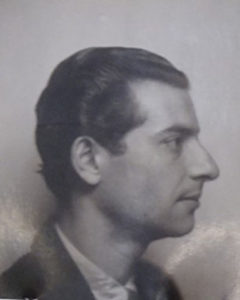 ΣΟΛΟΜΩΝ ΓΕΝΙ (1905-1944)
ΣΟΛΟΜΩΝ ΓΕΝΙ (1905-1944)
Έχει δημιουργηθεί ένας δικτυακός τόπος γύρω από τη βιογραφία του Σολομών Γενί, που την τοποθετεί μέσα στο ιστορικό της πλαίσιο.
I – Ο Σολομών Γενί στη Θεσσαλονίκη
Ο Σολομών Γενί γεννήθηκε στις 27 Δεκεμβρίου 1905 (ή 1906, σύμφωνα με διαφορετικές πηγές), τα τελευταία χρόνια της Οθωμανικής Αυτοκρατορίας, στη Θεσσαλονίκη.
Είναι Εβραίος (όπως το 51% του πληθυσμού της Θεσσαλονίκης εκείνη την εποχή, δηλαδή 86.000 άνθρωποι) και η οικογένειά του είναι πολύ ταπεινή (όπως το 75% των Εβραίων της Θεσσαλονίκης): ο πατέρας του Αβραάμ είναι έμπορος αυγών. Η μητέρα του, η Χάνα Ραφαέλ, κατάγεται από τη Σμύρνη.
Η Χάνα,η μητέρα του Σολομών.
Οι Εβραίοι της Θεσσαλονίκης, οι οποίοι πληρώνουν το «ντίμμι[1]», απολαμβάνουν μια σχετική θρησκευτική, πολιτιστική, γλωσσική και διοικητική αυτονομία.
Μιλούν ιουδαιοϊσπανικά (λαντίνο) και γαλλικά.
Δεδομένου ότι τα αρχεία της Θεσσαλονίκης κάηκαν το 1943, γνωρίζουμε πολύ λίγα πράγματα για τη ζωή του Σολομών Γενί μέχρι την ενηλικίωσή του. Αλλά το ιστορικό πλαίσιο μπορεί να μας βοηθήσει να αντιληφθούμε πώς ήταν η ζωή ενός νεαρού Εβραίου της Θεσσαλονίκης που γεννήθηκε στις αρχές του αιώνα και να κατανοήσουμε τι τον οδήγησε να μεταναστεύσει στη Γαλλία σε ηλικία 25 ετών.
Βασικά σημεία της ιστορίας του:
- 1908: Μια ομάδα νέων Τούρκων αξιωματικών από τη Θεσσαλονίκη και τη Μακεδονία κινητοποιείται εναντίον του σουλτάνου Αμπντούλ-Χαμίτ ΙΙ, κατηγορώντας τον για την παράδοση της Οθωμανικής Αυτοκρατορίας στις ξένες δυνάμεις και για υπερβολική επιείκεια προς τους Άραβες. Ο σουλτάνος υποχωρεί στις απαιτήσεις τους και επαναφέρει το Σύνταγμα στις 24 Ιουλίου 1908, δίνοντας ελπίδες για μια καλύτερη μοίρα των μειονοτήτων της Οθωμανικής Αυτοκρατορίας σε κοσμική βάση. Ωστόσο συμβαίνει το αντίθετο, με την άνοδο του εθνικισμού σε όλη την περιοχή των Βαλκανίων και τις αποτυχίες στους Βαλκανικούς Πολέμους και τον Α΄ Παγκόσμιο Πόλεμο.
- 1912: Με τον Α΄ Βαλκανικό Πόλεμο (1912-1913), η Οθωμανική Αυτοκρατορία αναγκάζεται να παραχωρήσει τη Μακεδονία. Η Θεσσαλονίκη γίνεται ελληνική. Οι Εβραίοι βλέπουν τη ζωή τους να αλλάζει υπό την πίεση των Ορθόδοξων Ελλήνων (υποχρέωση να κλείνουν τα καταστήματα δύο μέρες την εβδομάδα, Σάββατο και Κυριακή, οι μισθοί των μη Ορθοδόξων μειώνονται). Σε όλη την περιοχή οι Εβραίοι υφίστανται έξαρση του αντισημιτισμού.
- 1917: Μεγάλη πυρκαγιά στη Θεσσαλονίκη. Οι Εβραίοι δεν επιτρέπεται να ξαναχτίσουν στις παλιές γειτονιές του κέντρου της πόλης. Ανασυγκροτούν μια ενεργό ζωή στα περίχωρα της πόλης.
- Από το 1923: Άφιξη σχεδόν ενός εκατομμυρίου Ορθόδοξων Ελλήνων που εκδιώχθηκαν από την Τουρκία μετά την κατάρρευση της Οθωμανικής Αυτοκρατορίας. Από αυτούς 100.000 εγκαθίστανται στη Θεσσαλονίκη, με αποτέλεσμα να διπλασιαστεί σχεδόν ο αστικός πληθυσμός. Έτσι οι Εβραίοι της Θεσσαλονίκης, που μέχρι τότε ήταν δημογραφικά πλειοψηφία, γίνονται μειοψηφία.
- 1931: Πογκρόμ στη συνοικία Κάμπελ στη Θεσσαλονίκη, όπου ταραξίες αντισημίτες βάζουν φωτιά κατά τη διάρκεια της νύχτας.
- 1933: Ο Σολομών φεύγει από τη Θεσσαλονίκη για τη Γαλλία. Φτάνει στη Μασσαλία την 1η Νοεμβρίου.
[1] ειδικοί φόροι για τους μη μουσουλμάνους σε όλη την Οθωμανική Αυτοκρατορία
Χάρτης από τον Ντ. Βολτιέ
II – Ο Σολομών Γενί στη Γαλλία :
- 1933: Ο Σολομών Γενί φτάνει στη Γαλλία την 1η Νοεμβρίου μέσω του λιμανιού της Μασσαλίας. Δηλώνει ότι ήταν ράφτης στην Ελλάδα. Κατοικεί στο Παρίσι μέχρι το 1940.
- 1937: Τον Ιούλιο του 1937 ο Σολομών ζει στο Παρίσι με την αδελφή του Ραχήλ, η οποία έχει παντρευτεί. Ο αδελφός του Τζάκομπ έχει κι αυτός παντρευτεί στις Βρυξέλλες, όπου έχει εγκατασταθεί.
Ο Ισαάκ ΚΟΡΟΝΕΛ, ο Τζάκομπ ΓΕΝΙ και η σύζυγός του Ζαν, ο Σολομών ΓΕΝΙ τον Ιούλιο του 1937 στα Ηλύσια Πεδία
- 1939: Ο Σολομών είναι μεσίτης εμπορευμάτων στο Παρίσι. Ζει με την Κυρλά Μπούχλα Χέφτερ στην οδό Μερκέρ 6, στο 11ο διαμέρισμα στο Παρίσι. Η σύντροφός του φέρνει στον κόσμο ένα κοριτσάκι, την Αννέτ-Σεσίλ, στις 6 Ιανουαρίου 1939, αλλά η μητέρα πεθαίνει την ίδια μέρα, όπως πολλές γυναίκες μέχρι τη δεκαετία του 1950. Ο πατέρας αναγνώρισε την Αννέτ -Σεσίλ στις 9 Ιανουαρίου. Στη συνέχεια την άφησε σε μια εβραϊκή οικογένεια κοντά στο Μποβέ. Αναγνωρίστηκε από το κράτος το 1953, ενώ στη συνέχεια υιοθετήθηκε από τον Μαρσέλ Κλόπστειν και τη Μαντλέν Ντρέιφους το 1959 (πηγή: το Δικαστήριο του Σενλίς). Στις 27 Μαΐου 1965 στη Μασσαλία η Αννέτ – Σεσίλ παντρεύτηκε τον Μισέλ Λουί Αλεξάντρ Ρονιάν (29 Μαΐου 1928 στη Μασσαλία – 21 Οκτωβρίου 1974 στο Μποβέ). Έζησε κυρίως στο Κρεπί-αν-Βαλουά, την πόλη των θετών γονέων της, και στο Μποβέ του διαμερίσματος Ουάζ, όπου πέθανε την 1η Μαΐου 2019.
Όπως όλοι οι αλλοδαποί, από την άφιξή του στη Μασσαλία ο Σολομών υπόκειται σε υποχρεωτική δήλωση, η οποία αντιστοιχεί σε αίτηση για έκδοση δελτίου ταυτότητας. Αυτή η ταυτότητα αλλοδαπού εισήχθη κατά τη διάρκεια του Α’ Παγκοσμίου Πολέμου, με διάταγμα της 2ας Απριλίου 1917. Ήταν το πρώτο πείραμα στην Ευρώπη για τη στοχευμένη ταυτοποίηση όλων των αλλοδαπών κατοίκων στο εθνικό έδαφος. Το έγγραφο αυτό αποσκοπούσε στο να ελεγχθεί η αλλοδαπή εργασία, να εξασφαλιστεί ένα ακριβές νομικό καθεστώς για τους μετανάστες ως αλλοδαπούς υπηκόους και εργάτες και να υποβληθεί αυτός ο πληθυσμός σε ειδικό φόρο. Η απόκτηση δελτίου αντιστοιχούσε στην καταβολή φόρου.
Η κάρτα αυτή εκδίδεται από την Κεντρική Υπηρεσία Έκδοσης ταυτότητας αλλοδαπών (Service central de la Carte d‘identité des étrangers), η οποία υπάγεται στη Γενική Υπηρεσία Δημόσιας Ασφάλειας (Sûreté générale) του Υπουργείου Εσωτερικών.
Από τα τέλη της δεκαετίας του 1920 τα μέτρα αστυνομικού ελέγχου πολλαπλασιάστηκαν και το Υπουργείο Εσωτερικών συνέστησε στις νομαρχιακές αρχές να καταφύγουν σε ειδικά μέτρα επιτήρησης, τα οποία συνεχίστηκαν και αυξήθηκαν κατά τη διάρκεια του καθεστώτος του Βισύ.
- Δεκέμβριος 1939: Από τις πρώτες εβδομάδες του πολέμου ο Σολομών Γενί κατατάσσεται εθελοντικά στον γαλλικό στρατό ως αλλοδαπός. Η στρατολόγηση γίνεται στις 12 Δεκεμβρίου.
- 10 Μαΐου 1940: Ο Σολομών παντρεύεται την Εσθήρ Μπενμπασάτ, που γεννήθηκε στην Τουρκία στις 3 Μαΐου 1919. Η Εσθήρ είναι 21 ετών και ο Σολομών είναι 33.
 Ο Σολομών και η Εσθήρ παντρεύτηκαν στις 10 Μαΐου 1940.
Ο Σολομών και η Εσθήρ παντρεύτηκαν στις 10 Μαΐου 1940.
- 13 Μαΐου 1940: Ως αλλοδαπός εθελοντής, ο Σολομών στρατολογείται στο 213ο Σύνταγμα Πεζικού στις Βερσαλλίες. Υπηρετεί στον στρατό από εκείνη την ημερομηνία, αλλά δε συμμετέχει σε μάχες. Αποστρατεύεται στις 12 Ιουλίου 1940 στο Γκάρλιν στην περιοχή Λάντ. Η σύζυγός του είχε ήδη μετακομίσει εκεί.
- Ιούλιος 1940: Ο Σολομών βρίσκει τη σύζυγό του Εσθήρ. Ζουν στο Πο, μια πόλη που τότε βρισκόταν στη Νότια («ελεύθερη») Ζώνη.
- 1 Σεπτεμβρίου 1940: Ο Σολομών δηλώνει ότι έχει χάσει την ταυτότητά του ως βιομηχανικός αλλοδαπός εργάτης, όταν μετακινήθηκε στη Νότια Γαλλία, γι’ αυτό και υποβάλλει τακτικά αιτήματα στη Νομαρχία των Κάτω-Πυρηναίων. Λαμβάνει ένα αποδεικτικό που βεβαιώνει ότι έχει καταθέσει αίτημα χορήγησης δελτίου ταυτότητας, το οποίο και ανανεώνει τακτικά χάρη σε διάφορα πιστοποιητικά απασχόλησης. Έτσι γνωρίζουμε ότι ο Σολομών έκανε διάφορες δουλειές κατά τη διάρκεια του πολέμου: κατασκευαστής ζωνών, ράφτης, εργάτης στην εταιρεία Limonades du Béarn στο Πο, κ.τ.λ.
Η οικογένεια Γενί υποδέχεται συγγενείς: την οικογένεια Ραφαέλ στο Πο. Η οικογένεια Ραφαέλ αναγκάστηκε να εγκαταλείψει το Παρίσι: σ’αυτή τη φωτογραφία απεικονίζεται ο αρραβώνας του ξαδέλφου του Σολομών, Αρμάν Τζιγκλέρ, και της Ρενέ Ραφαέλ στις 30 Μαΐου 1943 στο Πο. Παντρεύτηκαν στις 24 Φεβρουαρίου 1944, 3 μήνες πριν από τη σύλληψη ολόκληρης της οικογένειας.
- Νοέμβριος 1942: Η Νότια («ελεύθερη») ζώνη καταλαμβάνεται από τους Γερμανούς.
- 16 Φεβρουαρίου 1943: Θέσπιση της Υποχρεωτικής Εργασίας (STO)[1]
[1] STO: Service du Travail Obligatoire. Στα ελληνικά αποδίδεται ως Εφαρμογή της Υποχρεωτικής Εργασίας. (Το STO ήταν ένα μέτρο που εφαρμόστηκε από το καθεστώς του Βισύ κατά τη διάρκεια της γερμανικής κατοχής (1942-1944), το οποίο υποχρέωνε Γάλλους πολίτες να εργαστούν στη ναζιστική Γερμανία, για να στηρίξουν τη στρατιωτική της οικονομία.
- 1940-1944: Καθ’ όλη τη διάρκεια της παραμονής του στο Πο, το ζεύγος Γενί υπόκειται επανειλημμένα σε διοικητικούς περιορισμούς που επιβάλλει το καθεστώς του Βισύ. Για να μην αναγκαστεί να εγκαταλείψει το Πο, το ζεύγος Γενί υποχρεούται να ζητάει άδεια παραμονής από τη Νομαρχία των Κάτω-Πυρηναίων, η οποία του χορηγήθηκε για πρώτη φορά την 1η Οκτωβρίου 1940 για 1 μήνα. Έτσι κάθε μήνα, καθ’ όλη τη διάρκεια του 1941, ο Σολομών και η σύζυγός του ανταλλάσουν αλληλογραφία με τη Νομαρχία των Κάτω-Πυρηναίων ζητώντας την παράταση της άδειας παραμονής τους. Από τις 2 Σεπτεμβρίου 1942 οι αιτήσεις γίνονται κάθε 3 μήνες, μέχρι την 1η Σεπτεμβρίου 1944.
 Ο Σολομών και η Εσθήρ (έγκυος σε δίδυμα) την άνοιξη του 1943.
Ο Σολομών και η Εσθήρ (έγκυος σε δίδυμα) την άνοιξη του 1943.
- 1 Ιουλίου 1943: Ο Σολομών εντάσσεται στην Αντίσταση την 1η Ιουλίου 1943 με τις Εσωτερικές Γαλλικές Δυνάμεις FFI[1] (δήλωση του υπολοχαγού Μποσερόν, ο οποίος τον στρατολόγησε), με τον βαθμό του λοχία (την 1η Μαΐου 1944), με το ψευδώνυμο Σιλβάν (εγκρίθηκε από τον συνταγματάρχη Dauphin, ψευδώνυμο Ντουκ, στις 26 Αυγούστου 1947).
- 10 Οκτωβρίου 1943: Γέννηση των διδύμων Γενί στην οδό Λεσπί 23, Πο: Αν-Βιβιάν και Αλμπέρ-Ζαν Κλοντ (γνωστός ως Τιστ). Το κοριτσάκι απεβίωσε στις 26 Δεκεμβρίου 1943.
Το ζεύγος Γενί και ο μικρός Ζαν Κλοντ την άνοιξη του 1944, λίγο πριν από τη σύλληψη του Σολομών.
Το κτίριο στην οδό Καζομπόν-Νορμπέρ 5, όπου ο Σολομών συνελήφθη μαζί με τα ξαδέλφια του Ραφαέλ από τη Γαλλική Πολιτοφυλακή και την Αστυνομία.
- 20 Μαΐου 1944: Ο Ζαν Κλοντ είναι 7 μηνών, όταν ο πατέρας του Σολομών συλλαμβάνεται από τη Γαλλική Πολιτοφυλακή και την Αστυνομία στο σπίτι των ξαδέλφων του στην οδό Καζομπόν Νορμπέρ 7 ως ύποπτος για πράξεις αντίστασης και μετά τη δολοφονία ενός πολιτοφύλακα τις προηγούμενες ημέρες.
Έγγραφο που συντάχθηκε από την Γαλλική Πολιτοφυλακή μετά τη σύλληψη του Σολομών (αρχεία Πο)
- 23 Μαΐου 1944: Ο Σολομών παραδίδεται στη Γκεστάπο, μεταφέρεται στις φυλακές Σαιν-Μισέλ της Τουλούζης και στη συνέχεια στο κέντρο της Κομπιέν.
- 6 Ιουλίου 1944: Ο Σολομών μεταφέρεται στο Ντρανσί.
- 31 Ιουλίου 1944: Ο Σολομών εκτοπίζεται με το Convoi 77 στο Άουσβιτς- αυτό είναι το τελευταίο μεγάλο Convoi εκτοπισμένων που φεύγει από τη Γαλλία (1.306 άτομα, τα περισσότερα από τα οποία είναι παιδιά), όταν οι Σύμμαχοι απέχουν μόλις 20 χιλιόμετρα από το Παρίσι. Κάθε ίχνος του Σολομών εξαφανίζεται από εκείνη την ημερομηνία και μετά.
- 5 Αυγούστου 1944: Το Convoi φτάνει στο Άουσβιτς-Μπίρκεναου.
- 27 Ιουλίου 1946: Μετά από πολλές αιτήσεις, το Υπουργείο Εμπορίου δίνει το πράσινο φως στην Εσθήρ (σύζυγο του Σολομών) να ανοίξει ένα κατάστημα πουκαμίσων και ειδών πλεξίματος στο Πο.
- Φεβρουάριος 1949: Η Εσθήρ τελικά πολιτογραφείται Γαλλίδα. Ξαναπαντρεύεται λίγες ημέρες αργότερα και αποκτά δύο κόρες από τον δεύτερο γάμο της.
- Οκτώβριος 1949: Μια διαπιστωτική απόφαση (από το δημαρχείο του Πο) αναφέρει ότι ο Σολομών πέθανε στις 31 Ιουλίου 1944 στο Ντρανσί.
- Μάρτιος 1950: Το Υπουργείο Βετεράνων και Θυμάτων Πολέμου ορίζει τελικά ως ημερομηνία θανάτου του Σολομών την 5η Αυγούστου 1944.
- Από το 1950 και μετά: η Εσθήρ (η σύζυγός του), η Aννέτ-Σεσίλ (η κόρη του από την πρώτη του σύντροφο) και στη συνέχεια ο Ζαν Κλοντ (ο γιος του από την Εσθήρ) ζητούν συστηματικά (και μέχρι το 2001) να αναγνωριστεί ο Σολομών Γενί μετά θάνατον ως « απελαθείς αντιστασιακός ». Η αίτηση κάθε φορά απορρίπτεται.
- 1972: Θάνατος της Εσθήρ.
Απόσπασμα από το γενεαλογικό δέντρο του Σολομών Γενί, που δημιουργήθηκε από τον Ντενίς Βολτιέ
Τα μέλη της οικογένειας του Σολομών Γενί που δολοφονήθηκαν κατά τη διάρκεια του Β’ Παγκοσμίου Πολέμου (1943 και 1944). Ο Σολομών φαίνεται κάτω αριστερά. Φωτομοντάζ του Ντενίς Βολτιέ
Ο Ζαν-Κλοντ Γενί, γιος του Σολομών Γιενί, με τον Ντενί Βολτιέ το 2018. Ο Ζαν-Κλοντ πέθανε από Covid τον Μάρτιο του 2020.
Οι τάξεις TG3 και TG6 του Λυκείου Victor Louis στην Ταλένς και οι καθηγήτριές τους, η κα Μπουτέ και η κα Ταντύ, θα ήθελαν να ευχαριστήσουν θερμά :
- τα Αρχεία του Πο, τα οποία ευγενικά διέθεσαν σκαναρισμένα έγγραφα που ήταν απαραίτητα για την εκπόνηση της παρούσας βιογραφίας.
- τον κ. Βολτιέ, χωρίς τον οποίο η βιογραφία αυτή θα ήταν λιγότερο ολοκληρωμένη. Συναντήθηκε με τις τάξεις TG3 και TG6 στο Λύκειο Victor Louis της Ταλένς και συνέβαλε στο να εμπλουτιστεί η βιογραφία με πολύτιμα επίσημα και προσωπικά έγγραφα.
- Αλεξάνδρα Χολέβα, καθηγήτρια στο 1ο Γυμνάσιο Ωραιοκάστρου (κοντά στη Θεσσαλονίκη), οι μαθητές της οποίας μοιράστηκαν αυτό το βιογραφικό έργο στα ελληνικά και στα αγγλικά μέσω ενός προγράμματος E–twinning.
Ο Ντενίς Βολτιέ έγραψε ένα βιβλίο με τίτλο « Le feu du diamant » (Η φωτιά του διαμαντιού) σχετικά με τη γενεαλογία της συζύγου του, που ήταν μικρανιψιά του Σολομών Γενί.
Πηγές :
- Αρχειακά έγγραφα που παραχωρήθηκαν από το Convoi 77
- Έγγραφα και φωτογραφίες που παραχωρήθηκαν από τον Ντενίς Βολτιέ
- Έγγραφα από τα αρχεία του διαμερίσματος των Ατλαντικών Πυρηναίων
Σύνδεσμοι :
- https://pboutet33.wixsite.com/website/post/biographie-de-salomon-yeni
- https://padlet.com/astealex2000/h6iqy6v5o3vsywbv
Ποιήματα της Σοφίας και της Μαρίας, Ωραιόκαστρο (περιοχή Θεσσαλονίκης)
Ποιητική γραφή από δύο Ελληνίδες μαθήτριες (Γ’ τάξης Λυκείου) του 1ου Λυκείου Ωραιοκάστρου (περίχωρα Θεσσαλονίκης) – Φεβρουάριος 2022. (Μετάφραση από τα Αγγλικά)
«Αναμνήσεις από το Ολοκαύτωμα» από τη Μαρία Αναστασιάδου
Ο άνεμος με κρατάει από το χέρι έτοιμος να με χωρίσει στα δύο, καθώς μπαίνω στο γκρίζο, άδειο δωμάτιο όπου, στοιβαγμένη με το πλήθος, χάνω κάθε κομμάτι του εαυτού μου και γίνομαι ένα με τη μάζα των ζώων στα οποία η μοίρα έχει γυρίσει την πλάτη. Ένα λουλούδι ανθίζει στο μαύρο πέπλο της ανυπαρξίας που μας καλύπτει. Κραυγές στην άβυσσο που κατευθύνονται προς την απόλυτη ανυπαρξία, όπως εμείς, αερικά που αιωρούνται μέχρι να φτάσουμε στο άσυλο, που ευτυχώς αποκαλούν παράδεισο. Μέχρι να φτάσουμε στην τρέλα και να ξεχάσουμε ότι είμαστε άνθρωποι με αξιοπρέπεια. Καθώς περνούν οι μέρες, οι κραυγές σταματούν, κουρασμένες από την άσκοπη κούρσα στο κενό. Περνάμε την πύλη με την επιγραφή « Η εργασία θα σας απελευθερώσει » και ασχημάτιστες μάζες με γκρίζα παλτό μάς κοροϊδεύουν και μας φτύνουν, μας βγάζουν τα ρούχα μόνο και μόνο επειδή μπορούν, παίζουν με τις ψυχές των ανθρώπων σαν να ήταν δικές τους, σαν να μην ήταν ποτέ παιδιά. Αφήνουμε την τελευταία μας πνοή με τη δυσωδία να καίει τους πνεύμονές μας και τον Θάνατο να κρατά το χέρι μας, οδηγώντας μας στην ασφάλεια. Όλα φαίνονται σαν ψεύτικη ανάμνηση, σαν αναμνήσεις από έναν παλιό εφιάλτη. Ωστόσο χαίρομαι που θυμάμαι ακόμα, χαίρομαι που έχω ακόμα τη δύναμη να φωνάζω ότι ήμουν, είμαι και θα είμαι πάντα άνθρωπος.
«Τους ακούς;» της Σοφίας Κουσενίδου
Ανεβαίνουν στο τρένο ελπίζοντας ότι υπάρχει κάτι να κερδίσουν. Το τρένο κάνει την πρώτη του κίνηση. Είναι ακόμα γεμάτοι ελπίδα για τη ζωή τους. Το τρένο κάνει μια κίνηση πάνω στις ράγες. Και τώρα δεν υπάρχει επιστροφή. Η στιγμή πλησιάζει…
Σταμάτα. Κλείσε τα μάτια. Άκου…
Τους ακούς;
Τα παιδιά κλαίνε, οι άνθρωποι πεθαίνουν.
Τους ακούς; Όταν φτάσει η στιγμή, η γη γίνεται ένα με τους πιο καυτούς λάκκους της κόλασης.
Τους ακούς; Τότε, φτάνει η στιγμή. Και όλοι όσοι γνώρισαν ποτέ, όλοι όσοι αγάπησαν ποτέ, ξαφνικά, πεθαίνουν…


 Français
Français Polski
Polski